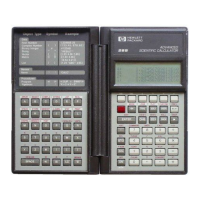HP-28S
RSD Returns the residual:
'B' 'A' 'X' RSD returns B – A*X in stack level 1.
A must be a matrix; B and X must be of the same type, either matrix or
vector.
CROSS Cross product of two length-3 vectors A and B returned as a length-3 vector:
[A2*B3-A3*B2, A3*B1-A1*B3, A1*B2-A2*B1]
DOT Scalar product of two equally-dimensioned vectors or matrices:
• [1 2 3] [4 5 6] DOT returns 1*4+2*5+3*6 = 32
• [[1 2] [3 4]] [[5 6] [7 8]] DOT returns
1*5+2*6+3*7+4*8 = 70
DET Returns the determinant of a square matrix.
ABS Returns the norm of a matrix or vector.
This is the square root of the sum of squares of all elements.
RNRM Row norm of a matrix or vector.
• For a vector this is the largest absolute value of all elements.
• For a nxm matrix: For each row sum up the absolute values of all n row
elements. Then take the largest value from these m sums. This returns
a single number.
CNRM Column norm. Same as RNRM but column-oriented.
For a vector this is the sum of the absolute values of all vector elements.
R→C Combine two real matrices or vectors into a complex matrix or vector where
the field in stack level 1 will be the imaginary part.
C→R Split a complex matrix or vector into real and imaginary part.
Stack level 1 will receive the imaginary part.
RE Return the real part of a real or complex matrix or vector.
IM Return the complex part of a real or complex matrix or vector.
For a real matrix/vector this will return a matrix/vector filled with zeros.
CONJ Conjugate a real or complex matrix or vector.
This will negate all imaginary parts.
Will do nothing on a real matrix or vector.
NEG (CHS) Negate each matrix or vector element.
BINARY Menu
General • "Binary" numbers are unsigned integer numbers with a maximum length of
64 bit.
• Binary numbers can be entered and displayed in binary, octal, decimal or
hex format (don't confuse binary display mode with the binary number
type!).
• Binary numbers are entered using the pound sign: #3A75C.
The digits must be valid for the selected number base.
• To enter a number in a number base other than the current one use a
trailing specifier: d (decimal), o (octal), h (hex), b (binary). Ie. #3Ah.
The number will automatically be converted to the current number base.
• Negative binary numbers are not supported.
+ - x ÷
These can be used on binary or mixed binary/real numbers.
The result will be a binary number with the fractional part cut off.
Binary and complex numbers cannot be combined.
10

